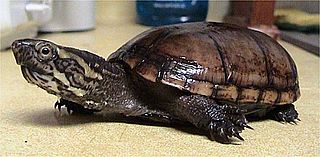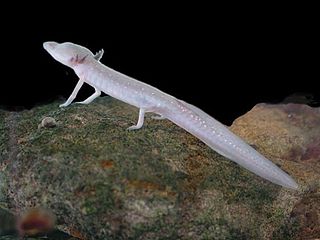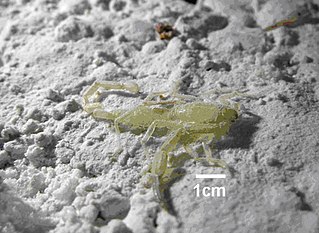
Scorpions are predatory arachnids of the order Scorpiones. They have eight legs and are easily recognized by a pair of grasping pincers and a narrow, segmented tail, often carried in a characteristic forward curve over the back and always ending with a stinger. The evolutionary history of scorpions goes back 435 million years. They mainly live in deserts but have adapted to a wide range of environmental conditions, and can be found on all continents except Antarctica. There are over 2,500 described species, with 22 extant (living) families recognized to date. Their taxonomy is being revised to account for 21st-century genomic studies.

Oaxaca, officially the Free and Sovereign State of Oaxaca, is one of the 32 states that compose the Federative Entities of Mexico. It is divided into 570 municipalities, of which 418 are governed by the system of usos y costumbres with recognized local forms of self-governance. Its capital city is Oaxaca de Juárez.

Pseudoscorpions, also known as false scorpions or book scorpions, are small, scorpion-like arachnids belonging to the order Pseudoscorpiones, also known as Pseudoscorpionida or Chelonethida.

The Ayalon Cave is a large limestone cave near Ramla, Israel, with a worldwide unique ecosystem. As photosynthesis is not possible inside the completely dark cave, the food chain that developed inside is solely based on bacteria capable of chemosynthesis: the bacteria are consuming the anorganic matter available in the groundwater, and then themselves become the organic food source for the rest of the food chain. As of 2021, Ayalon Cave was one of less than 10 such subterranean ecosystems known in the world, with each of them being distinctly different from the rest. Eight new invertebrate species were discovered there in April 2006 - four seawater and freshwater crustaceans along with four terrestrial animals, one of them a species of blind scorpion – with many more expected to be discovered.

Kinosternon is a genus of small aquatic turtles from the Americas known commonly as mud turtles.
The blackish deer mouse is a species of rodent in the family Cricetidae found only in Mexico, and is relatively poorly studied.

La Sierra Norte de Oaxaca is a heavily wooded region in the state of Oaxaca, Mexico. It is 62 km from the city of Oaxaca on Federal highway 175, heading east towards Tuxtepec. The region is divided into three districts: Ixtlán, which has 26 municipalities, Villa Alta, which has 25 municipalities and Mixe, which has 17 municipalities.

Abronia mitchelli, Mitchell's arboreal alligator lizard, is a species of arboreal alligator lizard in the family Anguidae. The species, which was originally described in 1982 by Jonathan A. Campbell, is endemic to southwestern Mexico.

Cavefish or cave fish is a generic term for fresh and brackish water fish adapted to life in caves and other underground habitats. Related terms are subterranean fish, troglomorphic fish, troglobitic fish, stygobitic fish, phreatic fish, and hypogean fish.
Robert Wetsel Mitchell was an American invertebrate zoologist and photographer who was particularly active in the study of the biology of caves.
Centruroides nigrimanus is a species of scorpion in the family Buthidae. This species is endemic of Mexico. It occurs in the Mexican states of Chiapas, Oaxaca and Guerrero. [Pocock 1998 indicated a juvenile specimen from Honduras might be this species, but this has never been substantiated, and unlikely]
Centruroides baergi is a species of scorpion in the family Buthidae. They are commonly found in highlands and are almost exclusively found in the states of Oaxaca and southern Puebla, Mexico. C. baergi is the most abundant scorpion of the genus in the state of Oaxaca, making up a third of Centruroides reported between 2008 and 2014.

Troglomorphism is the morphological adaptation of an animal to living in the constant darkness of caves, characterised by features such as loss of pigment, reduced eyesight or blindness, and frequently with attenuated bodies or appendages. The terms troglobitic, stygobitic, stygofauna, troglofauna, and hypogean or hypogeic, are often used for cave-dwelling organisms.
Pseudocellus mitchelli is an arachnid species in the order Ricinulei. It is endemic to caves in Durango, Mexico. The specific epithet is a tribute to cave biology specialist Robert W. Mitchell.

Akrav israchanani is an extinct species of scorpions from the Ayalon Cave in Israel. It is the only species in the genus Akrav and the family Akravidae.
Caecieleotris morrisi, also known as the Oaxaca cave sleeper is a species of troglobitic fish in the family Eleotridae found in a single cave system beneath Presa Miguel Alemán reservoir, northern State of Oaxaca in Mexico. This species is the only member of its genus.

Fusconaia mitchelli, the false spike, is a species of freshwater mussel, an aquatic bivalve mollusc in the family Unionidae, the river mussels.
Hemirrhagus is a genus of Mexican tarantulas that was first described by Eugène Louis Simon in 1903. It is considered a senior synonym of Spelopelma. Species of the genus Hemirrhagus are 5 to 12 cm long, usually black in colour, the urticating hairs on the opisthosoma are arranged in one dorsomedian patch, two dorsal paramedian patches, or two lateral patches. It is unique amongst the theraphosine genera because of the retrolateral coxal heels, the shape of the male palpal bulb, and the urticating hairs on the abdomen are reduced or completely missing. It is the only genus with epigean, troglophile and troglobitic species.
Aops is a monotypic genus of scorpions in the Urodacidae family. Its sole species is the troglobitic Aops oncodactylus, which is endemic to Australia. It was first described in 2008 by Erich Volschenk and Lorenzo Prendini.










